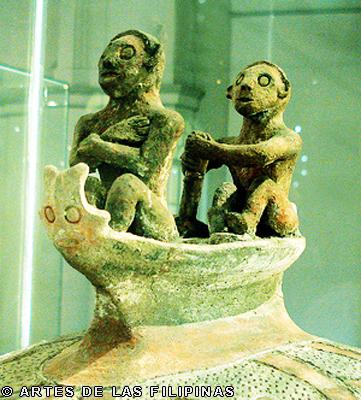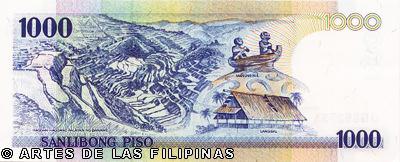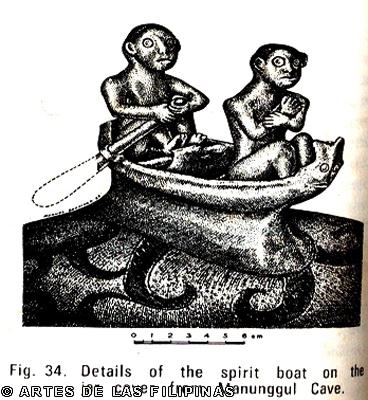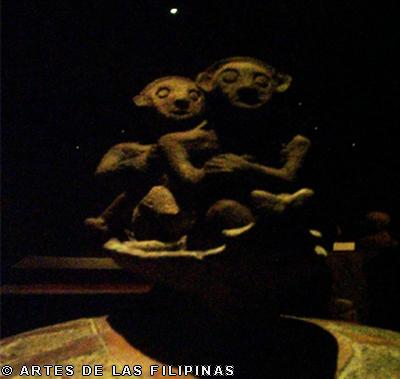
This elaborate burial jar is topped with two figures. The front figure is the deceased man. The rear figure is holding a steering paddle directing the boat and soul of the man to the afterlife.
| |
| Year | 890-710 B.C. |
|---|---|
| Type | Burial jar |
| Dimensions | 66.5 cm (26.2 in); 51 cm diameter (20 in)[1] |
| Location | Museum of the Filipino People,The National Museum, Manila |
The Manunggul Jar is a secondary burial jar excavated from a Neolithic burial site in Manunggul cave of Tabon Caves at Lipuun Point at Palawan dating from 890–710 B.C. The two prominent figures at the top handle of its cover represent the journey of the soul to the after life.
The Manunggul Jar is widely acknowledged to be one of the finest Philippine pre-colonial artworks ever produced and is a considered a masterpiece. It is denoted a national treasure and it is designated as item 64-MO-74 by the National Museum of the Philippines. It is now housed at the Museum of the Filipino People and is one of the most popular exhibits there. It is made from clay with some sand soil.
Discovery of the jar
It was found by Dr. Robert B. Foxel and Miguel Antonio in 1962. It was found alongside the discovery of the remains of Tabon Man. The faces of the figures and on the prow of the boat have eyes and mouth rendered in the same style as other artifacts of Southeast Asia of that period. Note the depiction of sea-waves on the lid. This style of decoration places this jar in the Sa-huýnh-Kalanay pottery tradition of Southern Vietnam. The steersman's oar is missing its paddle, as is the mast in the center of the boat, against which the steersman would have braced his feet. This symbolizes that they are traveling to the next life. In secondary burial, only bones were placed in the jar, and the jar itself is not buried.

The Manunggul jar was one of the numerous jars found in a cave believed to be a burial site (Manunggul, was part of the archaeologically significant Tabon Cave Complex in Lipuun Point, Quezon, Palawan) that was discovered on March 1964 by Victor Decalan, Hans Kasten and other volunteer workers from the United States Peace Corps. The Manunggul burial jar was unique in all respects. Dating back to the late Neolithic Period (around 710 B.C.), Robert Fox described the jar in his landmark work on the Tabon Caves:
The burial jar with a cover featuring a ship-of-the-dead is perhaps unrivalled in Southeast Asia; the work of an artist and master potter. This vessel provides a clear example of a cultural link between the archaeological past and the ethnographic present. The boatman is steering rather than padding the "ship." The mast of the boat was not recovered. Both figures appear to be wearing a band tied over the crown of the head and under the jaw; a pattern still encountered in burial practices among the indigenous peoples in Southern Philippines. The manner in which the hands of the front figure are folded across the chest is also a widespread practice in the Islands when arranging the corpse.
The carved prow and eye motif of the spirit boat is still found on the traditional watercraft of the Sulu Archipelago, Borneo and Malaysia. Similarities in the execution of the ears, eyes, nose, and mouth of the figures may be seen today in the woodcarving of Taiwan, the Philippines, and elsewhere in Southeast Asia.

My familiarity with the Manunggul jar was spurred by the image in the PHP1,000 bill, circulated in 1995. Viewing the artifact up close fascinated me tremendously. I saw the artistry of the early Filipinos reflected in those fine lines and intricate designs. We were definitely not as dumb as the Spaniards told us we were!
The carved prow and eye motif of the spirit boat is still found on the traditional watercraft of the Sulu Archipelago, Borneo and Malaysia. Similarities in the execution of the ears, eyes, nose, and mouth of the figures may be seen today in the woodcarving of Taiwan, the Philippines, and elsewhere in Southeast Asia.

My familiarity with the Manunggul jar was spurred by the image in the PHP1,000 bill, circulated in 1995. Viewing the artifact up close fascinated me tremendously. I saw the artistry of the early Filipinos reflected in those fine lines and intricate designs. We were definitely not as dumb as the Spaniards told us we were!
After a few years, when I took a cultural history subject during my undergraduate course in UP Diliman under Dr. Bernadette Lorenzo-Abrera, the Manunggul jar was given a whole new meaning. When an archaeological find was explained anthropologically, it was imbibed with far-reaching implications in re-writing its history.
The Manunggul jar served as a proof of our common heritage with our Austronesian-speaking ancestors despite the diversity of cultures of the Philippine peoples. Traces of their culture and beliefs were seen in different parts of the country and from different Philippine ethno-linguistic groups.
It was also a testament of the importance of the waters to our ancestors. The seas and the rivers were their conduit of trade, information and communication. According to Peter Bellwood, the Southeast Asians first developed a sophisticated maritime culture which made possible the spread of the Austronesian-speaking peoples to the Pacific Islands as far Madagascar in Africa and Easter Island near South America. Our ships—the balanghay, the paraw, the caracoa, and the like—were considered marvelous technological advances by our neighbors that they respected us and made us partners in trade. These neighbors later then, grew to include the imperial Chinese.

Many epics around the Philippines would tell us of how souls go to the next life aboard boats, passing through the rivers and seas. The belief was very much connected with the Austronesia belief in the anito. Our ancestors believed that man is composed of the body, the life force called the ginhawa, and the kaluluwa (soul). The kaluluwa, after death, can return to earth to exist in nature and guide their descendants. This explained why the cover of the Manunggul jar featured three faces: the soul, the boat driver, and of the boat itself. For them, even things from nature have souls and lives of their own. That’s why our ancestors respected nature more than those who thought that it can be used for the ends of man.
Seeing the Manunggul jar once more, I was also reminded of the inventiveness of the early Filipinos as well as the concepts and values they hold most-- their concept of the soul, for example, are believed to exist only on good-natured and merciful people. The belief was that the soul gave life, mind, and will to a person and if this was what our ancestors valued and exemplified, then our nation was not only great, but lived by compassionate people.
However, the colonial masters in the past labeled our ancestors no good and even tried to erase our legacies and values, and despite the media today showing how shameful, miserable and poor our country is, from time to time there would be people who echo the same values that our ancestors lived by.
In the 1890s, the Katipunan movement of Andres Bonifacio, which spearheaded the Philippine Revolution, tried to revive the values of magandang kalooban. During the People Power Uprising in1986, we showed the world the values of pananampalataya, pakikipagkapwa, pakikiramay, pagiging masiyahin, bayanihan, pagiging mapayapa, and pagiging malikhain --values that were deeply rooted in the Filipino culture. It was the country's national hero, José Rizal, who once wrote, in his essay, Filipinas Dentro de Cien Años, (The Philippines Within a Century) that:
With the new men that will spring from her bosom and the remembrance of the past, she will perhaps enter openly the wide road of progress and all will work jointly to strengthen the mother country at home as well as abroad with the same enthusiasm with which a young man returns to cultivate his father’s farmland so long devastated and abandons due to the negligence of those who had alienated it. And free once more, like the bird that leaves his cage, like the flower that returns to the open air, they will discover their good old qualities which they are losing little by little and again become lovers of peace, gay, lively, smiling, hospitable, and fearless.

The Manunggul jar was a symbol of the National Museum’s important role in spearheading the preservation the cultural heritage—pamana—using multi-disciplinary techniques. It was a testament of how art can be a vessel of history and culture with the help of scholars. In this light, a simple jar became the embodiment of the history, experiences, and aspirations of the people and how the values of maka-Diyos, makatao at makabansa became part the value system of the Filipinos.
The Manunggul jar served as a proof of our common heritage with our Austronesian-speaking ancestors despite the diversity of cultures of the Philippine peoples. Traces of their culture and beliefs were seen in different parts of the country and from different Philippine ethno-linguistic groups.
It was also a testament of the importance of the waters to our ancestors. The seas and the rivers were their conduit of trade, information and communication. According to Peter Bellwood, the Southeast Asians first developed a sophisticated maritime culture which made possible the spread of the Austronesian-speaking peoples to the Pacific Islands as far Madagascar in Africa and Easter Island near South America. Our ships—the balanghay, the paraw, the caracoa, and the like—were considered marvelous technological advances by our neighbors that they respected us and made us partners in trade. These neighbors later then, grew to include the imperial Chinese.

Many epics around the Philippines would tell us of how souls go to the next life aboard boats, passing through the rivers and seas. The belief was very much connected with the Austronesia belief in the anito. Our ancestors believed that man is composed of the body, the life force called the ginhawa, and the kaluluwa (soul). The kaluluwa, after death, can return to earth to exist in nature and guide their descendants. This explained why the cover of the Manunggul jar featured three faces: the soul, the boat driver, and of the boat itself. For them, even things from nature have souls and lives of their own. That’s why our ancestors respected nature more than those who thought that it can be used for the ends of man.
Seeing the Manunggul jar once more, I was also reminded of the inventiveness of the early Filipinos as well as the concepts and values they hold most-- their concept of the soul, for example, are believed to exist only on good-natured and merciful people. The belief was that the soul gave life, mind, and will to a person and if this was what our ancestors valued and exemplified, then our nation was not only great, but lived by compassionate people.
However, the colonial masters in the past labeled our ancestors no good and even tried to erase our legacies and values, and despite the media today showing how shameful, miserable and poor our country is, from time to time there would be people who echo the same values that our ancestors lived by.
In the 1890s, the Katipunan movement of Andres Bonifacio, which spearheaded the Philippine Revolution, tried to revive the values of magandang kalooban. During the People Power Uprising in1986, we showed the world the values of pananampalataya, pakikipagkapwa, pakikiramay, pagiging masiyahin, bayanihan, pagiging mapayapa, and pagiging malikhain --values that were deeply rooted in the Filipino culture. It was the country's national hero, José Rizal, who once wrote, in his essay, Filipinas Dentro de Cien Años, (The Philippines Within a Century) that:
With the new men that will spring from her bosom and the remembrance of the past, she will perhaps enter openly the wide road of progress and all will work jointly to strengthen the mother country at home as well as abroad with the same enthusiasm with which a young man returns to cultivate his father’s farmland so long devastated and abandons due to the negligence of those who had alienated it. And free once more, like the bird that leaves his cage, like the flower that returns to the open air, they will discover their good old qualities which they are losing little by little and again become lovers of peace, gay, lively, smiling, hospitable, and fearless.

The Manunggul jar was a symbol of the National Museum’s important role in spearheading the preservation the cultural heritage—pamana—using multi-disciplinary techniques. It was a testament of how art can be a vessel of history and culture with the help of scholars. In this light, a simple jar became the embodiment of the history, experiences, and aspirations of the people and how the values of maka-Diyos, makatao at makabansa became part the value system of the Filipinos.
I have visited the manunggul jar numerous times since that April of 1995 at the Kaban ng Lahi room of the National Museum II—The Museum of the Filipino People (former Department of Finance Building). Everytime, I look at it I am reminded of how great and compassionate the Filipinos are and how I could never be ashamed of being a Filipino. Everytime I look at the Manunggul jar, I see a vision that a new generation of Filipinos will once more take the ancient balanghay as a people and be horizon seekers once more.
From Wikipedia, the
free encyclopedia
No comments:
Post a Comment